 Many of my designs start with the yarn. I find some beautiful yarn, and then try to associate it with something that will become part of the theme of the shawl. For Verðandi I was looking at this skein of Fame Trend. The shades of green and gold and ash gray made me think of the giant ash Yggdrasil which the Norns tend to daily. It holds the nine worlds in its branches, and without it the worlds would collapse. And since Verðandi is the Norn representing the present, and Yggdrasil needs to be tended to in the present, I thought it was a good fit for the second shawl in the Norn series. So look for the leaves of Yggdrasil spreading out over the Verðandi shawl.
Many of my designs start with the yarn. I find some beautiful yarn, and then try to associate it with something that will become part of the theme of the shawl. For Verðandi I was looking at this skein of Fame Trend. The shades of green and gold and ash gray made me think of the giant ash Yggdrasil which the Norns tend to daily. It holds the nine worlds in its branches, and without it the worlds would collapse. And since Verðandi is the Norn representing the present, and Yggdrasil needs to be tended to in the present, I thought it was a good fit for the second shawl in the Norn series. So look for the leaves of Yggdrasil spreading out over the Verðandi shawl.
 Mystic Desire also started with a skein of yarn. I received a beautiful shawl of black lace from Blue Moon Fiber Arts overdyed in shades of green. I immediately started associating with sexy black lace, and romantic evenings by the fire. I knew I wanted to incorporate this somehow in the shawl, and ended up with a delicate heart motif as the main motif of the shawl. I also wanted to have very pronounced peaks along a very lacy edging, because I was hoping to “pique your interest” in the sexy black lace.
Mystic Desire also started with a skein of yarn. I received a beautiful shawl of black lace from Blue Moon Fiber Arts overdyed in shades of green. I immediately started associating with sexy black lace, and romantic evenings by the fire. I knew I wanted to incorporate this somehow in the shawl, and ended up with a delicate heart motif as the main motif of the shawl. I also wanted to have very pronounced peaks along a very lacy edging, because I was hoping to “pique your interest” in the sexy black lace.
All this is not to discourage you from choosing a different colour when knitting my patterns. One of my favourite parts of Ravelry is how easy it is to see the same shawl knit in many different colours and yarn, and how it changes the shawl. As I mentioned the other day, Skuld can be seen on Ravelry in MANY different colours, and each knitter has somehow tied it to their interpretation of the future, and they are all wonderful.
It usually takes a while to go from the yarn musings to the actual design and knitting of the shawl. The current colours swirling around in my head looking for firm associations are among others this beautiful skein of Sundara Silk Lace in Ruby Port.
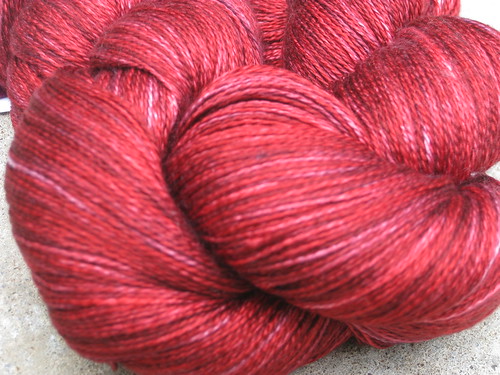
Another one that has been simmering for a while is Turtlepurl’s Satin Toes, although my mind has almost certainly locked this to granite. Luckily for me, I grew up in a landscape filled with granite – so there is lots to draw from.

 The next pattern in the Norns series is Verðandi. For this you will need one skein of Marks & Kattens Fame trend (single ply, 460 yds/420 m in a 100g skein). A few other yarns to consider might be Zauberball, Kauni or Sappho II. Other sock yarns in solid or semi-solid colours would also work.
The next pattern in the Norns series is Verðandi. For this you will need one skein of Marks & Kattens Fame trend (single ply, 460 yds/420 m in a 100g skein). A few other yarns to consider might be Zauberball, Kauni or Sappho II. Other sock yarns in solid or semi-solid colours would also work.
Colour-choices are up to you. My yarn has a lot of green (and some black/gray and golden-green) in it, and that works very well with the theme. The three norns live in a remote area of Aasgard, under the first root of Yggdrasil. They live in a dark cave, and in front of the cave is a well. The root of Yggdrasil snakes around the well. Each day the sisters collect water from the well and mix it with the magic clay and the coarse sand surrounding the well. They create a paste with which they cover the root to prevent rot and to preserve the life force of the tree.
Yggdrasil is the world tree – central to the nine worlds of Norse mythology. The tree has three roots that spread far and wide, to keep the trunk and the branches of the tree upright. The first root goes into Aasgard, where the gods live. The second goes to Jotunheim – home of the giants. And the third goes to Nifelheim.
As always, remember though that when you choose your yarn, you should pick something that *you* like. I have loved seeing all the different interpretations of Skuld – from the dark and unknown future I was envisioning, to misty gray, or the future seen through rose-coloured glasses, and the hopeful green.
The Verðandi pattern will be available on July 15.
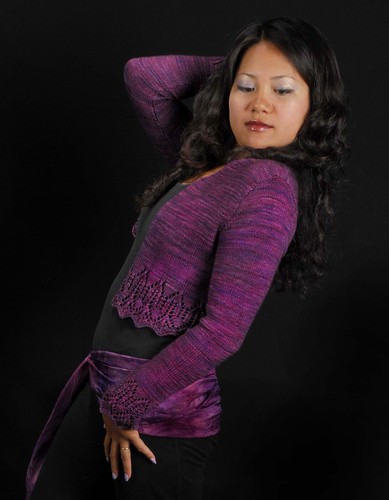 The Sanguine Gryphon released their 2010 summer line of patterns today, and I’m excited to announce that one of them is mine. This is the Cayuga Cardigan that I knit earlier in the spring.
The Sanguine Gryphon released their 2010 summer line of patterns today, and I’m excited to announce that one of them is mine. This is the Cayuga Cardigan that I knit earlier in the spring.
The Cayuga Cardigan is a half-length lacy cardigan, featuring a cathedral lace edging along the bottom edge and on the sleeve cuffs.
The cathedral lace motif is reminiscent of the clock tower at Cornell University. It lies on the top of a great hill overlooking Cayuga Lake.
The cardigan in the picture is size 38″, but the pattern is available in a wide range of sizes, from 34″-50″. It’s knit in Skinny Bugga! (450 yds/4 oz skein – merino/cashmere/nylon). My size used 2 skeins of yarn, but the larger sizes use a little more. I just loved knitting this cardigan with a hand-dyed semi-solid yarn. The colour variation in the stockinette portion kept my interest while knitting, and yet it doesn’t detract from the lace pattern at all.
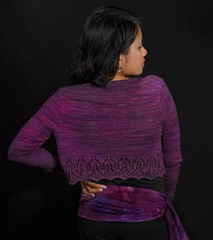
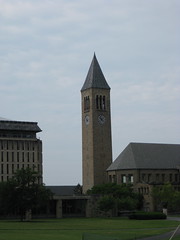
 The first shawl in the Norn series is Skuld. Skuld is one of the three Norns (Urðr, Verðandi and Skuld) in Norse mythology. The Norns spin the threads of life and death. The shawl show the intertwined threads of all living things.
The first shawl in the Norn series is Skuld. Skuld is one of the three Norns (Urðr, Verðandi and Skuld) in Norse mythology. The Norns spin the threads of life and death. The shawl show the intertwined threads of all living things.
The yarn used is dark blue and black, representing the dark and unknown future, since Skuld is the Norn representing that which should happen. It’s Sappho II from the Sanguine Gryphon in “Sleep Comes Down”. It’s also a single-ply yarn, like the yarn I imagine that the Norns spin for the threads of life.
At this point, the pattern is only available as part of the Seasons of Lace subscription.
Skuld in her natural environment in amongst the trees.
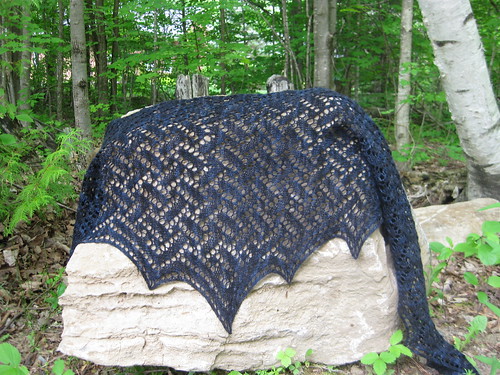
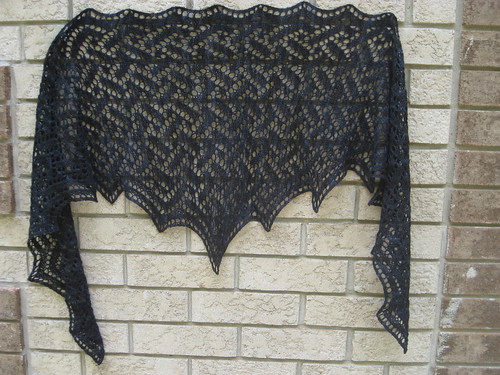
My favourite part of this shawl are the two endpoints. I really like how the edging continues along the top and the bottom V and meet in a point on the sides.
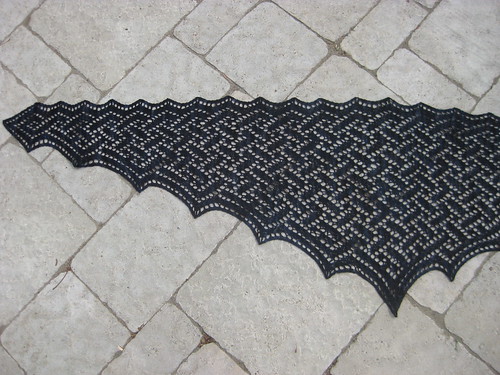
I’ve always liked math. And when it comes to math, geometry is particularly fun. All these fancy shapes and angles and lines that do or don’t intersect. I’m not certain that everyone shares my passion (actually, I’m certain that lots of people don’t), but the amazing thing with math is that there is a nice, neat solution to…. well…. everything. This interest in math has definitely carried over into my knitting.

When I first decided to design a triangular lace shawl, I thought about how one might construct a triangle. The first and most obvious solution came to mind – start at the bottom point and make the rows longer as you go. And thus Mystic Waters was born.
The inverse construction is of course also possible – I could have started at the top edge, cast on lots and lots of stitches and made each row shorter until I reached the point where I couldn’t decrease any further. The main draw-back in my mind of that method is that I really don’t like casting on lots and lots of stitches and counting them, and recounting them to be sure I have the right number. Sometimes it is of course a necessary exercise, but it’s so much simpler to start with two stitches. Or four. Or five. Or something more manageable than fourhundredandtwentyseven.
 Once I had created Mystic Waters though, I noticed that there are a lot of triangular shawls that are made out of TWO triangles. So then it was time for another experiment, which resulted in the Sumac Leaf Shawl. This shawl is constructed from two triangles starting at the nape of the neck and growing outwards so that the longest edge of each triangle forms the bottom edge of the shawl. This construction is easily recognizable, because there is a well defined “spine” of the shawl. It’s quite common, and can be seen in shawls like Icarus, Ishbel and Swallowtail. The advantage of this type of construction over the bottom-up triangle used for Mystic Waters is that the shawl drapes quite nicely over your shoulders. The fabric stretches in a different direction, and pulls evenly towards the bottom edges of the shawl. And once again you start with relatively few stitches.
Once I had created Mystic Waters though, I noticed that there are a lot of triangular shawls that are made out of TWO triangles. So then it was time for another experiment, which resulted in the Sumac Leaf Shawl. This shawl is constructed from two triangles starting at the nape of the neck and growing outwards so that the longest edge of each triangle forms the bottom edge of the shawl. This construction is easily recognizable, because there is a well defined “spine” of the shawl. It’s quite common, and can be seen in shawls like Icarus, Ishbel and Swallowtail. The advantage of this type of construction over the bottom-up triangle used for Mystic Waters is that the shawl drapes quite nicely over your shoulders. The fabric stretches in a different direction, and pulls evenly towards the bottom edges of the shawl. And once again you start with relatively few stitches.
It is also possible to do the inverse construction of this type of shawl, by casting on even more stitches to cover the entire bottom V of the shawl and then work towards the neck. The Miralda Triangular shawl by Nancy Bush is an example of that construction. But again, the fact that I can’t face the idea of casting on fourhundredandtwentyseven-times-two stitches has kept me from designing a shawl using this inverse construction.
These are just a few ways to construct triangles. There are several others as well, but those are probably the most common when it comes to shawls.
Almost all of my patterns have been a result of me experimenting with shapes and constructions. I do enjoy playing with different combinations of shapes. They all have their advantages and disadvantages, which are fun to figure out while knitting. And the one thing that I can promise all the participants of the Seasons of Lace, is that each and every shawl for the next six months will be constructed differently. The very first shawl, Skuld, is a triangle shawl constructed in a manner not used for any of my previous shawls. I hope you enjoy it.
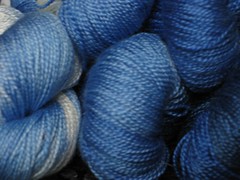 This is what is on my needles right now. I just received a shipment of Ling from Laura at the Unique Sheep. It’s part of their new Gradience collection, which in this case means that I received six 1-oz skeins in various shades of blue. The colourway is Illulissat, and ranges from a dark blue to a very light blue mixed with white. The skeins are numbered, and I chose to start at the dark end of the scale (#6) and work outwards towards the light. The yarn is lovely, really. I can’t show you any pictures of the actual shawl that is on my needles, since it’s part of the Norn series. The design was completed some time ago, but I was waiting for the perfect yarn, and here it is. So now my needles are burning as I’m working my way through the pattern.
This is what is on my needles right now. I just received a shipment of Ling from Laura at the Unique Sheep. It’s part of their new Gradience collection, which in this case means that I received six 1-oz skeins in various shades of blue. The colourway is Illulissat, and ranges from a dark blue to a very light blue mixed with white. The skeins are numbered, and I chose to start at the dark end of the scale (#6) and work outwards towards the light. The yarn is lovely, really. I can’t show you any pictures of the actual shawl that is on my needles, since it’s part of the Norn series. The design was completed some time ago, but I was waiting for the perfect yarn, and here it is. So now my needles are burning as I’m working my way through the pattern.
From what I understand, the Unique Sheep offers three different laceweight yarns – Ling (merino/silk), Eos (merino/tussah silk) and Ostara (cotton) which all knit up to the same gauge. I’ve worked with Eos before, and both Eos and Ling are quite nice, but of course the drape and the feel of the fabric is different.
I don’t know about you, but it seems to me that I often have multiple projects on the go in the same colour. So let me introduce you to my second current project……
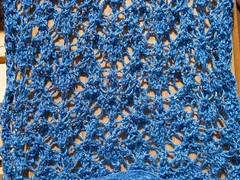 This is a lace scarf using some brand new yarn from FibroFibers. In fact, it is so brand new that it is not even available yet. Jen will be offering some Tussah lace-weight yarn, and sent me a sample. The colour is a cornflower blue (no idea what it will actually be called), and it is gorgeous. I couldn’t wait to cast-on, and I’m using the sample for a small lace scarf. The tussah silk has a small “halo” to it, and the halo combined with the sky blue colour made me think of angels. So here is a small section of my scarf with little angels spreading their wings.
This is a lace scarf using some brand new yarn from FibroFibers. In fact, it is so brand new that it is not even available yet. Jen will be offering some Tussah lace-weight yarn, and sent me a sample. The colour is a cornflower blue (no idea what it will actually be called), and it is gorgeous. I couldn’t wait to cast-on, and I’m using the sample for a small lace scarf. The tussah silk has a small “halo” to it, and the halo combined with the sky blue colour made me think of angels. So here is a small section of my scarf with little angels spreading their wings.
 And just so you don’t think I’m blind to all colours but blue, here’s the yarn for the third thing I’m working on. This is Nightfall from FibroFibers. It’s a fingering weight 100% merino, and this particular skein is in Ivy. The yarn changes colour from Ivy to black. The plan is to start from the dark centre of the skein and work myself towards the lighter colours.
And just so you don’t think I’m blind to all colours but blue, here’s the yarn for the third thing I’m working on. This is Nightfall from FibroFibers. It’s a fingering weight 100% merino, and this particular skein is in Ivy. The yarn changes colour from Ivy to black. The plan is to start from the dark centre of the skein and work myself towards the lighter colours.
The Eyjafjallajökull Shawl pattern is now available.
The pattern is inspired by some of the amazing pictures of the erupting volcano. The lava streams starts at the centre of the shawl and streams outwards towards the edges and pool there.
It’s about 160 cm (63″) in diameter and is knit with fingering weight yarn.
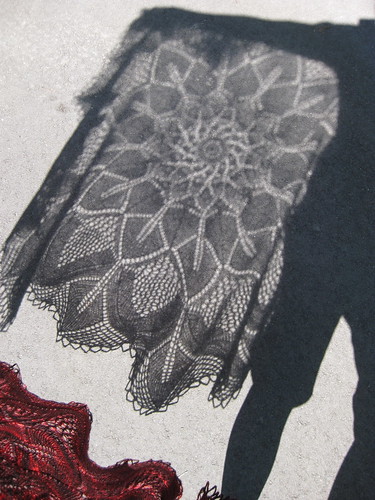
I’m often asked how I come up with the new designs for various lace shawls. As I’m sure you can imagine, the process is a little bit different every time.
This particular shawl began with some yarn. 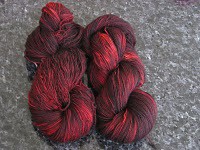 Last year when I visited the Sanguine Gryphon at her fabulous dye camp, I dyed some Little Traveller yarn in shades of red and black. I was really pleased with how it turned out (and amazingly it’s a little bit similar to a couple of her official colourways – The Middle of Nowhere and Rojas). I’ve always meant to use this for a lace shawl, but I hadn’t quite figured out what the theme should be. So it’s been sitting in my stash since last May, just waiting for the right design.
Last year when I visited the Sanguine Gryphon at her fabulous dye camp, I dyed some Little Traveller yarn in shades of red and black. I was really pleased with how it turned out (and amazingly it’s a little bit similar to a couple of her official colourways – The Middle of Nowhere and Rojas). I’ve always meant to use this for a lace shawl, but I hadn’t quite figured out what the theme should be. So it’s been sitting in my stash since last May, just waiting for the right design.
In March, and then again in April the Eyjafjallajökull volcano erupted on Iceland. And on the news we saw spectacular pictures of the volcano, the lava, and (of course) the ash-clouds that are still disrupting air traffic occasionally. And whatever else the erupting volcano might be, some of those pictures were truly amazing, and my imagination started running wild with fires and streams of lava.
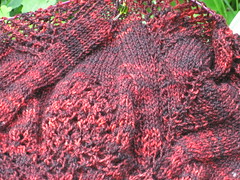 And then the Little Traveller yarn caught my eye again, and seemed to look just like the smouldering lava that had been forming in my imagination. Naturally this shawl had to be a circular shawl, so that the lava could start in the centre and work its way out.
And then the Little Traveller yarn caught my eye again, and seemed to look just like the smouldering lava that had been forming in my imagination. Naturally this shawl had to be a circular shawl, so that the lava could start in the centre and work its way out.
As with all hand-dyed yarn, I had only a limited amount of yarn, with no possibility of getting more yarn to match, so it’s been important to me to use it as efficiently as possible. After finishing the first skein, I calculated how many more rounds I would get out of the second skein, and (with a small margin) designed the pattern to extend as far as possible.
The shawl should be ready in the next few days – I just have to work the edging and then of course block it. Blocking always works wonders on lace, and particularly on shawls knit in the round. During the actual knitting the shawl is so bunched up on the needles that it’s hard to see the pattern develop, and that makes the blocking transformation even more amazing.
 I had a lovely visit to Turtlepurl‘s studio last week. As it turns out, she is located in the Ottawa area – just across the river, on the Quebec side. It’s a little less than one hour’s drive from my house, assuming you don’t go during rush hour.
I had a lovely visit to Turtlepurl‘s studio last week. As it turns out, she is located in the Ottawa area – just across the river, on the Quebec side. It’s a little less than one hour’s drive from my house, assuming you don’t go during rush hour.
Turtlepurl showed me around, and we had a wonderful time looking at all her amazing yarns and thinking up projects for them. My hands down favourite was the Satin Toes. It’s a fingering weight merino/tencel blend. The tencel makes it so shiny – similar to a silk blend – and also very strong. She has lots of different colours, and it was very hard to choose, but I ended up with two skeins of this silver gray colour. This yarn will be perfect for one of my upcoming lace shawls.
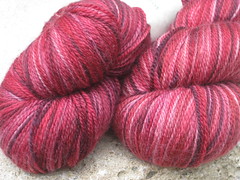 I also managed to get two skeins of Pillow Talk – a light fingering MCN in “Love Me” which I am planning to use for a sweater for my daughter. I think the colour will suit her perfectly. I actually have a great idea already for what to knit her, but with the heatwave we’ve been having recently (+30C and clear blue skies) I don’t think there’s any rush. She won’t be able to wear it until the fall anyway.
I also managed to get two skeins of Pillow Talk – a light fingering MCN in “Love Me” which I am planning to use for a sweater for my daughter. I think the colour will suit her perfectly. I actually have a great idea already for what to knit her, but with the heatwave we’ve been having recently (+30C and clear blue skies) I don’t think there’s any rush. She won’t be able to wear it until the fall anyway.
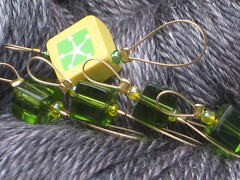 Last, but certainly not least, I got a set of stitch-markers. These stitch-markers are really cool. They are called thick-and-thin stitch-markers, and have a small loop on one side and a large loop on the other side. The small side fits up to 3.5 mm needles, and the large side up to 8 mm needles. The loops are also soft, which I really like. It makes them so much easier to manage on the needles. They have already been put to good use on my latest project.
Last, but certainly not least, I got a set of stitch-markers. These stitch-markers are really cool. They are called thick-and-thin stitch-markers, and have a small loop on one side and a large loop on the other side. The small side fits up to 3.5 mm needles, and the large side up to 8 mm needles. The loops are also soft, which I really like. It makes them so much easier to manage on the needles. They have already been put to good use on my latest project.
 Skuld is the first shawl in a series of three shawls on the theme of the three Norns (Urðr, Verðandi and Skuld) in Norse mythology. The determine the fate of all living creatures by spinning the threads of life. And they water Yggdrasil – the tree of life – so the branches do not dry out or rot.
Skuld is the first shawl in a series of three shawls on the theme of the three Norns (Urðr, Verðandi and Skuld) in Norse mythology. The determine the fate of all living creatures by spinning the threads of life. And they water Yggdrasil – the tree of life – so the branches do not dry out or rot.
Skuld is the Norn representing the future, and since the future is dark and unknown for us mortals, I choose to use Sappho II from the Sanguine Gryphon in “Sleep Comes Down”. The colours are dark blues and black.
The Norns are responsible for spinning the threads of life for all living things, and our lives are all intertwined. Skuld is a triangular shawl designed around the idea of the threads of life and our intertwined lives. The pattern will be available on June 15 as part of the Seasons of Lace series.


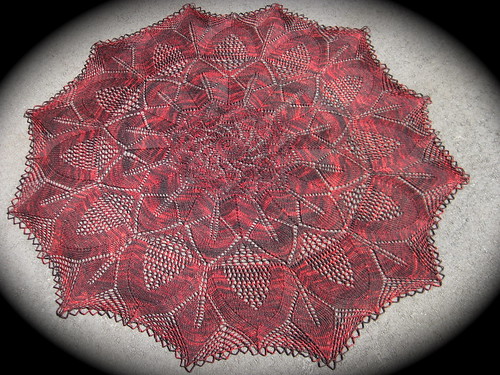

Recent Comments